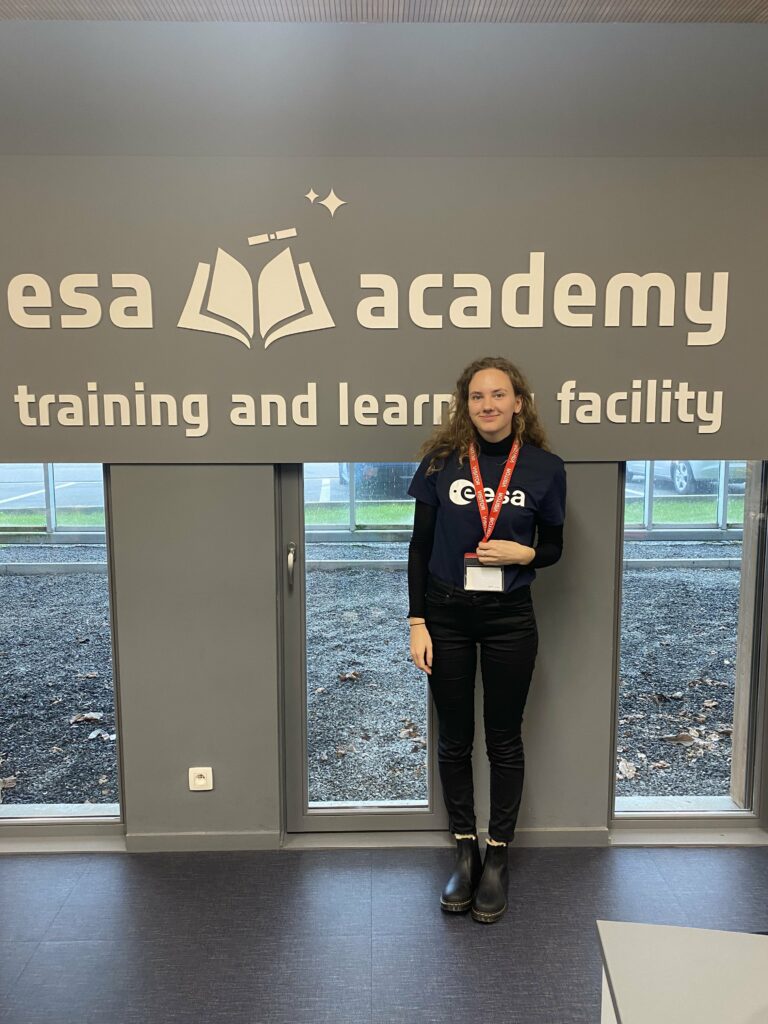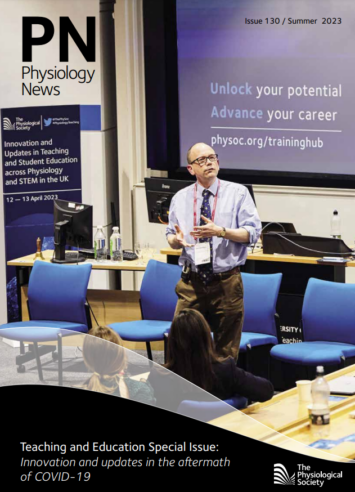
Physiology News Magazine
Space physiology: Broadening the horizons of health research
Membership
Space physiology: Broadening the horizons of health research
Membership
https://doi.org/10.36866/pn.130.46
Sara Valkila
University of Aberdeen, UK
Are you a life science student who is interested in space? If not, maybe you should be. Before I attended the European Space Agency’s (ESA) training programme, I knew very little about space physiology. I am a 3rd year BSc student at the University of Aberdeen, UK, studying biomedical science and specialising in anatomy in my honour’s years. For the past two and half years studying countless modules related to physiology, it had never occurred to me how much Earth’s gravity has affected the evolution of our physiology. I thought that space research was about unravelling the story of our universe and discovering celestial bodies but it turns out it can also help us know more about health and disease as well.
In November 2022, I travelled to the ESA Academy training facility in Belgium, for the Human Space Physiology Training Course 2022. I had first heard about this course from my professor the previous year. Around 30 of us medical, biomedical, and other life science students from all around Europe gathered to learn about the physiological challenges that astronauts operating on the International Space Station (ISS) or on the lunar surface have to face. The training course is an exclusive opportunity to learn from cutting-edge researchers in the field of space medicine, physiology, and biomedical engineering to further our understanding of the physiological effects that the space environment has on the human body.

Why study space physiology?
Space has fascinated me since I was a child and I have always cheered for space programmes. However, with my interests lying in medical science, I felt I could not contribute to the field and so never really considered it as a possible career path. When I heard about the ESA training programme, I immediately recognised the doors it could open in the future and how wrong I had been.
Space physiology is a beautifully niche area of research and has numerous applications outside space exploration. It provides an opportunity to literally think beyond the confines of the Earth to consider how living systems could exist outside of it. Physiology tells the story of the mechanisms underlying all life. Imagining how humans could sustain life on, for example Mars, forces you to harness all that knowledge. An environment that involves high doses of radiation, extreme temperature changes and microgravity provide a unique set of challenges that you do not encounter in your day-to-day physiology problems. On this course we were taught how these challenges have been reconciled so far and which research methods can benefit us in the future in supporting the health and performance of a human in space. Personally, I could not think of a more inspiring task.
An intensive course covering all major areas of space physiology
During the course, experts working on research ranging from earth-based analogues conducted at the Concordia research facility on the Antarctic Plateau to physiologists and medical experts training new astronauts were giving lectures and sharing their findings. Every day involved two to five lectures, which would each be followed by a Q&A session, as well as allocated time to work on group projects. We also had the privilege of an exclusive visit to the European Space Centre, the European Space Security and Education Centre (ESA ESEC). Despite the intensive schedule there was plenty of time for networking and socialising with not only the students but the visiting lecturers and researchers.
One does not have to be a space enthusiast to get on board as the programme start with a crash course into the history of human spaceflight and the role of ESA in the global space exploration community. The 20 lectures on the course gave a comprehensive view of human spaceflight and how the physiological effects are studied. Examples of topics covered:
- space environment and its challenges
- work of the Space Medicine Team
- neurosensory and neuromuscular function in space
- effects on cardiovascular and skeletal physiology
- the technological innovations that aim to counter deconditioning in space
- methods of human space research
Applying space mission research to the clinical health setting
I personally most enjoyed the session covering the impact of space on the brain and the neurosensory system as well as the musculoskeletal system. Some of the negative changes, such as muscular atrophy, loss of bone density, and neuroinflammatory stress that astronauts experience during and after space flight are commonly associated with ageing. I believe that these groundbased analogues, originally designed for human spaceflight research, could potentially be used to identify biomarkers related to neurodegenerative disease.
I was particularly fascinated by how changes in neuroanatomy and neurophysiology lead to adaptations and that there are many examples of neuroplasticity. That being said I would highly recommend this course to anyone interested in studying neurodegeneration and plasticity. The course also offers a lot to exercise physiologists and sport scientists interested in performance and reconditioning as this is potentially the most significant aspect of maintaining astronauts’ overall health and performance during their mission.
Each session ended with a Q&A with the person giving the talk. These discussions were really the essence of this course as they allowed the students to contribute their own expertise or knowledge and share it with everyone. Being from a science background myself, it was particularly interesting to listen to medical students cleverly apply their knowledge from the clinical setting to the healthcare of astronauts. For me, this is what made the course so special.
On the group projects we focused on the challenges of human spaceflight in the future and how to produce a roadmap to safer space exploration. This was a fun project as we got to apply the physiological knowledge of the researchers as well as study the literature. I personally was not familiar with the topic nor the relevant literature, which was challenging, but we had access to experts from whom we could ask questions and receive help.
A future at ESA or the Space Medicine Team?
The variety of speakers on the course demonstrated that the paths to ESA or space physiology research in general are incredibly varied and that people come from many backgrounds to participate in this multicultural and interdisciplinary community that is surrounding space medicine. One of the sessions inspired me to design cell culture experiments that apply my lab internship experience to the study of inflammation and neurodegeneration in space.
It definitely had an impact on my way of thinking about interdisciplinary research. That one session inspired an idea for my own PhD project, where I would like to design experiments that could benefit the space physiology community. I had not considered a career in industry, but this programme made me think of space physiology as an intermediate option somewhere between academia and industry. This training programme is an entirely one-of-a-kind opportunity for students to develop their graduate attributes in physiology and the organisers are openly encouraging participants to consider ESA as a career option.
How to take part in the programme
Biomedical and medical students both at the BSc and MSc level can apply each year on ESA’s website. To apply, students must submit a CV, an abstract and a motivational letter as well as academic transcripts and reference letters. Background knowledge in physiology could help you gain more out of the course and familiarising yourself with the relevant literature will help you draft a strong application. At the end of the course students are awarded a course certificate, university credits, and a grade for their group project. Thus, it is also a way to add something unique to one’s academic records. Some of the MSc-level students on the course were already running their own projects with ESA or were planning to do their master’s thesis on space physiology. It is a great place to get inspiration and make connections that might open doors in the future.
